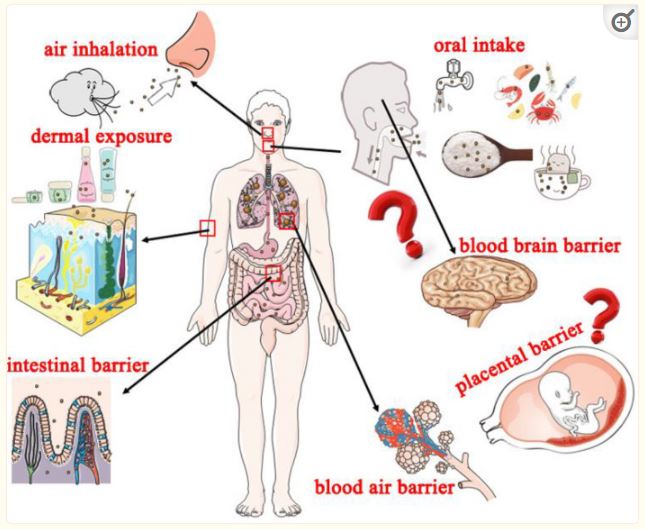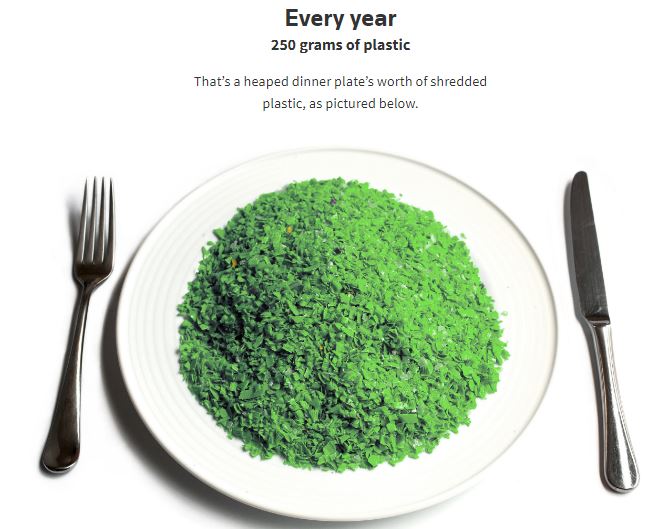Micro- and Nanoplastics are everywhere
Micro- and Nanoplastics are everywhere
Children especially are moved with compassion for animals. I remember learning as a child that non-biodegradable plastic often ends up in the ocean, and sea animals like birds and fish can get entangled in plastics like 6-pack rings, so I started to cut apart the rings before throwing them away so that the animals wouldn’t strangle. Later I learned that some plastic bags were being manufactured as “biodegradable”; this was some relief to my mind. However, the newest question is, into what are they degrading? It turns out that plastics are coming back to us in invisible ways when they break down into microplastics and nanoplastics.
Microplastics, artificial polymer particles with size less than or equal to 5 mm, were initially reported in 2004 (2022 study: Nanoplastics and Human Health: Hazard Identification and Biointerface). They are produced from disintegration of plastic products, from the ubiquitous plastic shopping bags to a child’s toy stroller to an empty jug of laundry detergent. Small millimeter-sized pieces of plastic seem like they would produce a lot of plastic “sand” that could be filtered out of water or even pass through our digestion system unchanged. Yet microplastics are not the end product; nanoplastics are. Nanoplastics are particles with a size ranging between 1 nm and 1 μm, which cannot be seen by the human eye.
Nanoplastics come from a lot of different sources and some surprising ones. We’ve written about different harmful nanoparticles that can be emitted into the air and water: from ceramic coated cooking pans, 3D printers, dust particles, from combustion engines, graphene, household cleaning products, and microfibers that get released in your washing machine and dryer (some of which are actually nanoplastics). Here’s a new one to us: huge amounts of nanoplastics are released by car and truck tires every year by the simple acts of driving and braking.
According to National Geographic, “Tires are actually among the most common plastic polluters on earth. A 2017 study by Pieter Jan Kole at The Open University of The Netherlands, published in the International Journal of Environmental Research and Public Health, estimated that tires account for as much as 10 percent of overall microplastic waste in the world’s oceans. A 2017 report by the International Union for Conservation of Nature put that number at 28 percent.”
“Today tires consist of about 19 percent natural rubber and 24 percent synthetic rubber, which is a plastic polymer.” Considering that each (car) tire will lose about 1.5-2 lbs of weight over its lifetime, which is the wear of rubber and plastics from it, millions of tires on our roads add up to tons of micro- and nanoplastics.
Nanoplastics are dangerous to the environment and to us. The following diagram shows the many ways our bodies are exposed to them:
(Source: 2022 study: Nanoplastics and Human Health: Hazard Identification and Biointerface)
Oral ingestion has been the most studied route, and as we understand how nanoplastics affect our food sources (fish and meats, plants, water, etc.), we can understand how they build up in our own bodies. There are surprising methods of ingestion, though–namely in the packaging of foods that are not expected to release plastics. For instance, it was discovered in 2019 that steeping tea in plastic bags releases billions of micro- and nanoparticles into the tea. (study) Even “healthy” foods like apples and pears have been found to have 100,000-200,000 plastic particles per gram, which are thought to be taken up through contaminated water and the plant’s root system. (greenpeace.org)
Other routes of ingestion are gaining attention, however. Inhalation is acutely dangerous, because inhaled nanoparticles are able to deposit deep in the lungs where they induce oxidative stress and inflammation; they also accumulate at sites of vascular disease. (2017 study). The lung’s ample surface area enables particles to quickly accumulate to large concentrations in the lung and lung-associated tissues. (physicstoday.org) Dermal exposure can occur when taking a shower or using personal care products like soaps, lotions and deodorants.
Once inside the body, nanoplastics can cross the intestinal barrier, the blood-air barrier (in the lungs), blood-brain barrier and the placental barrier. They even enter cells, as described in a 2022 study. Cultured human liver and lung cells were treated with different amounts of 80 nm-wide plastic particles. After two days, electron microscopy images showed that nanoplastics had entered both types of cells without killing them. Further study of the cells revealed that the microplastics affected the metabolic processes of the cells, even causing some mitochondrial pathways to be dysfunctional (these determine the aging and death of cells). So, even though the nanoplastics did not kill the cells, they could have adverse affects on the organ as a whole. This may be because plastics are made with hydrocarbons (fossil fuels including oil and natural gas) and many different types of chemicals. Some of these chemicals are already known as hazardous, like bisphenols, such as bisphenol A (BPA), and phthalates, which can flow or leach into the foods touched by plastic, especially when that plastic is warmed. (consumerreports.org)
In shrimp, nanoplastics become stuck in their gills and ball up in their guts (National Geographic). In fish, nanoplastics induced brain damage and behavioral disorders (2017 study). Across the board, free nanoplastics in the air, soil, water and in our foods are not good.
How much microplastics are we ingesting every year? Here are some sources:
With salt: Based on international research, it is possible that humans may be consuming around 20,000 microplastic particles a year with an average of ten grams of daily salt intake. (greenpeace.org)
They can also enter the body when we drink from plastic bottles, with people who drink 1.5 to 2 litres of water a day from these bottles taking in 90,000 plastic particles per year. (euronews.com)
In total, the Medical University of Vienna published a study in the journal Exposure & Health which suggests that on average, five grams of plastic particles enter the human gastrointestinal tract per person, per week. (euronews.com) This is equivalent to a heaped dinner plate of plastic per year.
Photo source: reuters.com
What are these plastics causing?
Ingested particles passing through the gastrointestinal tract lead to changes in the composition of the gut microbiome. These changes are linked to metabolic diseases like obesity, diabetes and chronic liver disease. “The particles can trigger local inflammation and immune response, and nanoplastics in particular have been found to trigger chemical pathways involved in the formation of cancer,” reads the study. (euronews.com)
Large polystyrene particles - around the size of a cloud or fog droplet at 10 micrometers - can make their way into the placenta, according to scientists at Utrecht University. Their effects on the fetus are unclear. (euronews.com)
What can we do today to avoid ingesting them?(euronews.com and consumerreports.org)
Microwave food in ceramic or glass dishes instead of plastic containers.
Avoid putting plastics in the dishwasher because of the high heat involved in cleaning.
Avoid storing foods in plastics–so you won’t be tempted to reheat or eat from them! Weck is a brand highly recommended for its durability. They also have glass lids with a rubber seal, which do not contain plastics.
Vacuum regularly with a HEPA vacuum, because it can help to avoid inhaling dust with plastics.
Avoid plastic packaging when buying food. The obvious are those such as “steam in bag” containers and styrofoam ramen noodle containers, but you can also ask your butcher to wrap meat in wax paper instead of plastic, and you can bring reusable cloth bags instead of plastic ones to bring home groceries.
Try to eat seafood that does not contain the “guts” or gills of the animal, because this is where microplastics originate. Mussels, oysters, and other filter-feeding animals, may be more likely to carry microplastics to your dinner plate. (forbes.com) In the same way, avoid eating the digestive parts of land animals such as chicken gizzards, pork intestines, etc., even though these are considered delicacies in some parts of the world! (theconversation.com)
Drink filtered tap water instead of bottled water, as filtered water almost halves the ingested particles compared to bottled water. Granulated Activated Carbon (GAC) will remove some microplastics, but nanofiltration (with a pore size of 0.001 micrometers) and reverse osmosis are the best methods to remove nanoplastics from water. This review shows which water pitcher filters are best at removing microplastics.
Try to avoid living near congested roadways and highways, which throw a lot of nanoplastics from tires into the air.
Clothing releases a lot of synthetic particles during washing. A microfiber-catching filter in your laundry machine could keep microplastics from washing out. More importantly, try to avoid synthetic fibers altogether and instead opt for natural materials like cotton, wool, silk, and hemp.
Don’t use or buy cosmetics with microbeads. Cosmetics companies were allowed to add microbeads until 2015, but some still contain them. A “Beat the microbead” app is available to show you if your cosmetics contain them!
In the future, mussels may play a large part in filtering the sea water that contains microplastics. According to a study by the UK’s Plymouth Marine Laboratory, one square meter of mussel bed can filter an enormous 150,000 liters of water per day. They do it without harming themselves, and expel the plastics in larger particles of feces, which can be more easily filtered from the water. (euronews.com)
It’s sad what the “convenience” of plastics has turned into: a poison to us and to our environment. With some extra effort now, though, we can minimize the amount of plastics we ingest and put back into the environment, especially the bits we can’t even see.
Photo by John Cameron on Unsplash



